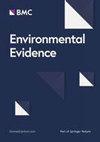光伏板对生物多样性影响的现有证据:一个系统的地图与研究有效性的关键评估
IF 5.2
4区 环境科学与生态学
Q2 ENVIRONMENTAL SCIENCES
引用次数: 0
摘要
为了逐步淘汰化石燃料,实现碳中和的未来,太阳能,尤其是光伏(PV)装置正在迅速扩大规模。与风能和水力发电等其他类型的可再生能源不同,关于光伏装置对生物多样性影响的证据直到最近才开始积累,并表明它们可能通过生境变化和丧失、死亡率、行为改变或人口迁移等方式直接影响生态系统和物种。因此,我们对现有证据进行了系统的映射,旨在回答以下问题:关于光伏装置对野生陆生和半水生物种的影响,存在哪些证据?我们在四个在线出版数据库、谷歌学术、四个专业网站和灰色文献征集中搜索了相关引文。然后对引文进行筛选,以便仅保留涉及野生陆生和半水生物种以及光伏和太阳能热装置的引文,因此不包括聚光太阳能发电。在元数据提取过程中,接受的文章首先被分成研究(对应于一个实验设计),然后进一步分成观察(即一个人群和一个结果)。对文献的现状进行了描述,并确定了知识集群和差距。检索获得8121条唯一引用,筛选后获得158篇相关文章。虽然第一篇文章发表于2005年,但在2020年发表率迅速上升。纳入的97篇主要研究和建模文章被分成137个独立研究,在内部效度评估后,被评为低(43.8%)、高(41.6%)或总体偏倚风险不明确(14.6%)。研究进一步分为434次观测,主要在美国(23.0%)和英国(21.0%)进行,优先在温带气候(64.5%)进行。植物和节肢动物是研究最多的两个分类群(分别为41.7%和26.3%)。公用事业规模的太阳能(USSE)设施是最常被调查的(70.1%)。观察主要集中在光伏装置存在的影响上(51.8%)。物种丰度、群落组成和物种多样性是最常见的评估结果(分别为23.0%、18.4%和16.1%)。确定了应考虑进行系统审查的三个知识集群:(i)光伏装置对植物和(ii)节肢动物群落的影响,以及(iii)它们在更大的生态系统尺度上对总体物种丰度的影响。然而,目前关于光伏装置对生物多样性影响的证据仍然很少。迫切需要对不会飞的哺乳动物和蝙蝠以及两栖动物和爬行动物进行更多的研究。太阳能热板和浮动光伏装置也应进一步研究。还应研究比较不同的光伏装置设计、管理实践或环境。事实上,还需要更多的证据来让决策者准确可靠地选择光伏装置的类型和对生物多样性破坏最小的管理实践。本文章由计算机程序翻译,如有差异,请以英文原文为准。
Existing evidence on the effects of photovoltaic panels on biodiversity: a systematic map with critical appraisal of study validity
To phase out fossil fuels and reach a carbon–neutral future, solar energy and notably photovoltaic (PV) installations are being rapidly scaled up. Unlike other types of renewable energies such as wind and hydroelectricity, evidence on the effects of PV installations on biodiversity has been building up only fairly recently and suggests that they may directly impact ecosystems and species through, for instance, habitat change and loss, mortality, behaviour alteration or population displacements. Hence, we conducted a systematic map of existing evidence aiming at answering the following question: what evidence exists regarding the effects of PV installations on wild terrestrial and semi-aquatic species? We searched for relevant citations on four online publication databases, on Google Scholar, on four specialised websites and through a call for grey literature. Citations were then screened for eligibility in order to only retain citations referring to wild terrestrial and semi-aquatic species as well as PV and solar thermal installations, therefore excluding concentrated solar power. Accepted articles were first split into studies (corresponding to one experimental design) subjected to critical appraisal and then further split into observations (i.e. one population and one outcome) during metadata extraction. The current state of the literature was characterised and knowledge clusters and gaps identified. Searching captured 8121 unique citations, which resulted in 158 relevant articles being accepted after screening. Even though the first article was published in 2005, the publication rate increased rapidly in 2020. The 97 included primary research and modelling articles were split into 137 unique studies and rated with either a low (43.8%), a high (41.6%) or an unclear overall risk of bias (14.6%) after internal validity assessment. Studies were further split into 434 observations, mainly carried out in the United States (23.0%) and the United Kingdom (21.0%), preferentially in temperate climates (64.5%). Plants and arthropods were the two most studied taxa (41.7% and 26.3%, respectively). Utility-scale solar energy (USSE) facilities were most often investigated (70.1%). Observations mainly focused on the effect of the presence of PV installations (51.8%). Species abundance, community composition and species diversity were the most common outcomes assessed (23.0%, 18.4% and 16.1%, respectively). Three knowledge clusters for which a systematic review should be contemplated were identified: (i) the effects of PV installations on plant and (ii) arthropod communities and, (iii) their effects at a larger ecosystem scale on overall species abundance. However, the currently available evidence regarding the effects of photovoltaic installations on biodiversity is still scarce. More research is urgently needed on non-flying mammals and bats as well as amphibians and reptiles. Solar thermal panels and floating PV installations should also be further investigated. Studies comparing different designs of PV installations, management practices or contexts should be conducted as well. Indeed, more evidence is still needed to allow decision-makers to accurately and reliably select the types of PV installations and management practices that are least damaging to biodiversity.
求助全文
通过发布文献求助,成功后即可免费获取论文全文。
去求助
来源期刊

Environmental Evidence
Environmental Science-Management, Monitoring, Policy and Law
CiteScore
6.10
自引率
18.20%
发文量
36
审稿时长
17 weeks
期刊介绍:
Environmental Evidence is the journal of the Collaboration for Environmental Evidence (CEE). The Journal facilitates rapid publication of evidence syntheses, in the form of Systematic Reviews and Maps conducted to CEE Guidelines and Standards. We focus on the effectiveness of environmental management interventions and the impact of human activities on the environment. Our scope covers all forms of environmental management and human impacts and therefore spans the natural and social sciences. Subjects include water security, agriculture, food security, forestry, fisheries, natural resource management, biodiversity conservation, climate change, ecosystem services, pollution, invasive species, environment and human wellbeing, sustainable energy use, soil management, environmental legislation, environmental education.
 求助内容:
求助内容: 应助结果提醒方式:
应助结果提醒方式:


